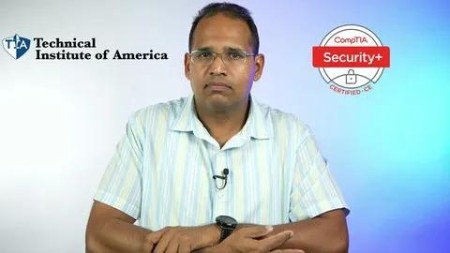Most Commented
Comptia Security+ Sy0701 Full Course, Labs, And Study Plan




Description material

Comptia Security+ Sy0-701 Full Course, Labs, And Study Plan
Last updated 6/2024
MP4 | Video: h264, 1920x1080 | Audio: AAC, 44.1 KHz
Language: English | Size: 48.11 GB | Duration: 25h 48m
Pass your Security+ SY0-701 in 30 days or less on the first try. Full Study Plan with labs and practice exams.
What you'll learn
CompTIA Security+ exam objectives
Attacks against networks
Methods to protect a network
Full length Mock Exam
Requirements
Basics Networking and skills.
Description
This course will prepare you to pass the CompTIA Security+ SY0-701 exam on the first try. In this course, I will be using my 20+ years of experience teaching IT courses to give you a practical, hands-on approach to all of the CompTIA Security+ Certification exams. I will cover all of the exam objectives in detail. I am a best-selling udemy instructor with over 300,000 students. I have helped thousands of students to pass their certification exams over the last 20 years. My method of teaching is engaging and fun.I will review how to build your own lab to follow along with me on this journey so you can gain the practical knowledge needed not only to pass your Security+ exam but also how to apply it in the real world of being an IT technician.This course will cover the following domains:Attacks, Threats, and VulnerabilitiesArchitecture and DesignImplementationOperations and Incident ResponseGovernance, Risk, and ComplianceThis course will include:Over 250 lectures.Over 25 Hours of training.We will only be covering the topics on your exam, no-nonsense and personal stories.PDF of the exam objectives from CompTIA for the Security+ exam. Certificate of completion. Lifetime access. 30-day money-back guarantee.
Overview
Section 1: Introduction
Lecture 1 Course Layout
Lecture 2 30 Day Study Plan
Lecture 3 Exam Information
Lecture 4 Exam Domains
Lecture 5 Course Objectives, Notes and Cram Guide Download
Section 2: Lesson 1: IT Security Fundamentals
Lecture 6 Introduction IT Security Fundamentals OB 1.2
Lecture 7 CIA Triad OB 1.2
Lecture 8 Confidentiality OB 1.2
Lecture 9 Integrity OB 1.2
Lecture 10 Availability OB 1.2
Lecture 11 DAD Triade OB 1.2
Lecture 12 Zero Trust OB 1.2
Lecture 13 Non-Repudiation OB 1.2
Lecture 14 Authentication OB 1.2
Lecture 15 Authorization OB 1.2
Lecture 16 Accounting OB 1.2
Lecture 17 Accountability OB 1.2
Lecture 18 Gap analysis OB 1.2
Section 3: Security Controls Categories and Types
Lecture 19 Control Categories OB 1.1
Lecture 20 Control Types OB 1.1
Lecture 21 Defense in Depth OB 1.1
Section 4: Threats
Lecture 22 Threats Motivation OB 2.1
Lecture 23 Threats OB 2.1
Lecture 24 Attributes of Actors OB 2.1
Lecture 25 Nation-state OB 2.1
Lecture 26 Unskilled Attacker OB 2.1
Lecture 27 Hacktivist OB 2.1
Lecture 28 Organized Crime OB 2.1
Lecture 29 Shadow IT OB 2.1
Lecture 30 Threat Vectors and Attack Surfaces OB 2.2
Section 5: Vulnerabilities
Lecture 31 Vulnerabilities OB 2.3
Lecture 32 Memory injection and buffer overflows OB 2.3
Lecture 33 Race Conditions OB 2.3
Lecture 34 Malicious Updates OB 2.3
Lecture 35 OS-Based Vulnerabilities OB 2.3
Lecture 36 SQL Injections OB 2.3
Lecture 37 XSS OB 2.3
Lecture 38 Hardware Vulnerabilities OB 2.3
Lecture 39 VM Vulnerabilities OB 2.3
Lecture 40 Cloud-specific Vulnerabilities OB 2.3
Lecture 41 Supply Chain Vulnerabilities OB 2.3
Lecture 42 Cryptographic Vulnerabilities OB 2.3
Lecture 43 Misconfiguration OB 2.3
Lecture 44 Mobile Device Vulnerabilities OB 2.3
Lecture 45 Zero-day Vulnerabilities OB 2.3
Section 6: Signs of Attacks
Lecture 46 Malware OB 2.4
Lecture 47 Viruses OB 2.4
Lecture 48 Worms OB 2.4
Lecture 49 Trojans OB 2.4
Lecture 50 Ransomware OB 2.4
Lecture 51 Spyware OB 2.4
Lecture 52 Rootkit OB 2.4
Lecture 53 Logic Bomb OB 2.4
Lecture 54 Keyloggers OB 2.4
Lecture 55 Bloatware OB 2.4
Lecture 56 DDOS OB 2.4
Lecture 57 DNS OB 2.4
Lecture 58 Onpath Attack OB 2.4
Lecture 59 Credential Replay OB 2.4
Lecture 60 Privilege Escalation OB 2.4
Lecture 61 Request Forgery OB 2.4
Lecture 62 Directory Traversal OB 2.4
Lecture 63 Indicators of Malicious Activity OB 2.4
Section 7: Cryptography
Lecture 64 Intro to cryptography OB 1.4
Lecture 65 Crypto Terms OB 1.4
Lecture 66 Goals Cryptography OB 1.4
Lecture 67 Algorithm vs Keys OB 1.4
Lecture 68 Ciphers OB 1.4
Lecture 69 Symmetric Encryption OB 1.4
Lecture 70 Symmetric Algorithms OB 1.4
Lecture 71 Asymmetric Encryption OB 1.4
Lecture 72 Asymmetric Algorithms OB 1.4
Lecture 73 Hybrid Cryptography OB 1.4
Lecture 74 Hashing OB 1.4
Lecture 75 Hashing Algorithms OB 1.4
Lecture 76 Digital Signatures OB 1.4
Lecture 77 Intro to PKI OB 1.4
Lecture 78 PKI Purpose OB 1.4
Lecture 79 SSL/TLS Handshake OB 1.4
Lecture 80 PKI Process OB 1.4
Lecture 81 Certificates OB 1.4
Lecture 82 PKI Root of Trust OB 1.4
Lecture 83 PKI Verification and Revocation OB 1.4
Lecture 84 Steganography OB 1.4
Lecture 85 Blockchain OB 1.4
Lecture 86 Salting OB 1.4
Lecture 87 TPM OB 1.4
Lecture 88 Secure Enclave OB 1.4
Lecture 89 Obfuscation OB 1.4
Lecture 90 Tokenization OB 1.4
Lecture 91 Key Escrow OB 1.4
Lecture 92 HSM OB 1.4
Section 8: Social Engineering
Lecture 93 Social Engineering OB 2.2
Lecture 94 Phishing OB 2.2
Lecture 95 Vishing OB 2.2
Lecture 96 Smishing OB 2.2
Lecture 97 Spear Phishing OB 2.2
Lecture 98 Misinformation and Disinformation OB 2.2
Lecture 99 Impersonation OB 2.2
Lecture 100 Business Email Compromise OB 2.2
Lecture 101 Pretexting OB 2.2
Lecture 102 Watering Hole OB 2.2
Lecture 103 Brand Impersonation OB 2.2
Lecture 104 Typosquatting OB 2.2
Lecture 105 Training against Phishing OB 5.6
Lecture 106 Security Awareness Program OB 5.6
Section 9: Securing IT Assets
Lecture 107 Segmentation OB 2.5
Lecture 108 Isolation OB 2.5
Lecture 109 Access Control OB 2.5
Lecture 110 Principles of Least Privilege OB 2.5
Lecture 111 Access Control List OB 2.5
Lecture 112 Filesystem Permissions OB 2.5
Lecture 113 Application Allow List OB 2.5
Lecture 114 Patching OB 2.5
Lecture 115 Configuration Enforcement OB 2.5
Lecture 116 Decommissioning OB 2.5
Lecture 117 Monitoring OB 2.5
Lecture 118 Hardening Techniques OB 2.5
Section 10: Security Architecture
Lecture 119 Cloud OB 3.1
Lecture 120 Infrastructure as Code OB 3.1
Lecture 121 Serverless Architecture OB 3.1
Lecture 122 Microservices OB 3.1
Lecture 123 Air Gapped OB 3.1
Lecture 124 Software-Defined Networking OB 3.1
Lecture 125 On-Premises OB 3.1
Lecture 126 Centralized vs. Decentralized OB 3.1
Lecture 127 Virtualization OB 3.1
Lecture 128 Containerization OB 3.1
Lecture 129 High Availability OB 3.1
Lecture 130 IoT OB 3.1
Lecture 131 ICS OB 3.1
Lecture 132 RTOS and Embedded Systems OB 3.1
Lecture 133 Security Architecture Considerations OB 3.1
Section 11: Security Principles
Lecture 134 Infrastructure Considerations OB 3.2
Lecture 135 Device Placement OB 3.2
Lecture 136 Security Zones OB 3.2
Lecture 137 Attack Surface OB 3.2
Lecture 138 Failure Modes OB 3.2
Lecture 139 Device Attributes OB 3.2
Lecture 140 Network Appliances and Sensors OB 3.2
Lecture 141 Jump Server OB 3.2
Lecture 142 Proxy Servers OB 3.2
Lecture 143 IDS/IPS OB 3.2
Lecture 144 Load Balancer OB 3.2
Lecture 145 802.1x and EAP OB 3.2
Lecture 146 Firewalls OB 3.2
Lecture 147 VPN OB 3.2
Lecture 148 SD-WAN OB 3.2
Lecture 149 Selecting Effective Controls OB 3.2
Section 12: Data Protection
Lecture 150 Regulated Data OB 3.3
Lecture 151 Intellectual Property OB 3.3
Lecture 152 Legal and Financial Data OB 3.3
Lecture 153 Data Classification OB 3.3
Lecture 154 Geolocation and Sovereignty OB 3.3
Lecture 155 Methods to Secure Data OB 3.3
Section 13: Common Security Techniques
Lecture 156 Secure Baselines OB 4.1
Lecture 157 Hardening Devices OB 4.1
Lecture 158 Installations of Mobile Devices OB 4.1
Lecture 159 Mobile Solutions and MDM OB 4.1
Lecture 160 Mobile Connection Methods OB 4.1
Lecture 161 Wireless Security OB 4.1
Lecture 162 Application Security Methods OB 4.1
Lecture 163 Security Monitoring OB 4.1
Section 14: Hardware, software and Data Asset Management
Lecture 164 Acquisition Procurement OB 4.2
Lecture 165 Assignment and Accounting OB 4.2
Lecture 166 Monitoring and Tracking OB 4.2
Lecture 167 Disposal and Decommission OB 4.2
Section 15: Vulnerability Management
Lecture 168 Vulnerability Scan OB 4.3
Lecture 169 Application Security Testing OB 4.3
Lecture 170 Threat Feeds OB 4.3
Lecture 171 Penetration Testing OB 4.3
Lecture 172 Bug Bounty Program OB 4.3
Lecture 173 False Positive vs. False Negative OB 4.3
Lecture 174 CVE and CVSS OB 4.3
Lecture 175 Vulnerability Responses OB 4.3
Lecture 176 Internal and External Assessments OB 5.5
Section 16: Alerting and Monitoring IT
Lecture 177 Monitoring Resources OB 4.4
Lecture 178 Monitoring Activities OB 4.4
Lecture 179 Alerting and Monitoring Tools SIEM and DLP's OB 4.4
Section 17: Enhance Security
Lecture 180 Firewall Configuration OB 4.5
Lecture 181 Web Filters OB 4.5
Lecture 182 Operating System Security OB 4.5
Lecture 183 Secure Protocols OB 4.5
Lecture 184 DNS Filter OB 4.5
Lecture 185 Email security OB 4.5
Lecture 186 File Integrity Monitoring OB 4.5
Lecture 187 Network Access Control OB 4.5
Lecture 188 EDR OB 4.5
Lecture 189 User Behavior Analytics OB 4.5
Lecture 190 Deception and Disruption Technology OB 1.2
Lecture 191 Automation and Orchestration OB 4.7
Section 18: Identity and Access Management (IAM)
Lecture 192 Provisioning Users OB 4.6
Lecture 193 Single Sign-on OB 4.6
Lecture 194 Federation and SAML OB 4.6
Lecture 195 Access Control Models OB 4.6
Lecture 196 Multifactor Authentication OB 4.6
Lecture 197 Authentication tokens OB 4.6
Lecture 198 Biometric OB 4.6
Lecture 199 Password Management OB 4.6
Section 19: Incident Response
Lecture 200 Incident Response Steps OB 4.8
Lecture 201 Incident Response Training OB 4.8
Lecture 202 Digital Forensics OB 4.8
Lecture 203 Types of logs OB 4.9
Section 20: Security Governance and Privacy
Lecture 204 Security Polices, Standards, Guidelines and Procedures OB 5.1
Lecture 205 Security Governance Considerations and Revisions OB 5.1
Lecture 206 Security Governance Structures OB 5.1
Lecture 207 Security Governance Roles OB 5.1
Lecture 208 Compliance Reporting OB 5.4
Lecture 209 Privacy OB 5.4
Section 21: Risk Management
Lecture 210 Risk Terms OB 5.2
Lecture 211 Risk Identification and Assessment Times OB 5.2
Lecture 212 Quantitative and Qualitive Risk Assessment OB 5.2
Lecture 213 Risk Register OB 5.2
Lecture 214 Risk Appetite OB 5.2
Lecture 215 Risk Response OB 5.2
Lecture 216 Business Impact Assessment OB 5.2
Section 22: Vendor Management
Lecture 217 Vendor Assessment and Selection OB 5.3
Lecture 218 Vendor Agreements OB 5.3
Section 23: Physical Security
Lecture 219 Physical Security OB 1.2
Section 24: Change Management
Lecture 220 Change management OB 1.3
Lecture 221 Technical Implications OB 1.3
Section 25: Resilience and Recovery
Lecture 222 High Availability OB 3.4
Lecture 223 Site Selection OB 3.4
Lecture 224 Capacity Planning OB 3.4
Lecture 225 Testing OB 3.4
Lecture 226 Backups OB 3.4
Lecture 227 Power OB 3.4
Section 26: Labs
Lecture 228 Lab intro
Lecture 229 Installing Windows on VirtualBox
Lecture 230 Installing Kali Linux
Lecture 231 Using Snapshots
Lecture 232 Using an IP Scanner
Lecture 233 Using the Nessus Vulnerability scanner
Lecture 234 Cracking a Password with Kali
Lecture 235 Cracking a password with a lookup table
Lecture 236 Scanner a website for vulnerabilities
Lecture 237 Using Wireshark to capture network traffic
Lecture 238 Installing and Using SSH
Lecture 239 Securing Windows with Password Complexity
Lecture 240 Using Steganography to hide messages
Lecture 241 Encrypting a hard drive
Lecture 242 Implementing Role Based Access Control in Windows
Lecture 243 Assigning Permissions to folders
Lecture 244 Configure Firewall rules
Lecture 245 Updating a Computer
Lecture 246 Hardening a Desktop using group policy
Lecture 247 Securing a wireless network
Lecture 248 Using Encrypting File System
Lecture 249 Backing up router configuration
Lecture 250 Updating firmware on a router
Lecture 251 Configuring a DMZ
Lecture 252 Using tor network
Lecture 253 Configuring VLAN's
Lecture 254 Setting up an IPS
Lecture 255 Configuring web filters
Section 27: Mock Exam
Anyone looking to get CompTIA Security+ Certified

https://fikper.com/FyrQaK4vyV/
https://fikper.com/cUbRJAiHon/
https://fikper.com/AVm3qEqZni/
https://fikper.com/ud5W5YMGRL/
https://fikper.com/64kSQwY6P8/
https://fikper.com/6nnVE4O7GN/
https://fikper.com/nlqbXHqtHd/
https://fikper.com/FwFodDTJoc/
https://fikper.com/VhuPWtvlQ0/
https://fikper.com/sftruGTJUR/
https://fikper.com/2FhTT28cH3/
https://fikper.com/JagfBrGocc/
https://fikper.com/3104rFu9TU/
https://fikper.com/zvREVmXDgp/
https://fikper.com/5tAsxFcqCO/
https://fikper.com/MVMB1HO1Oz/
https://fikper.com/uzSauAwTTC/
https://fikper.com/RuEAmNy2ch/
https://fikper.com/j6Jo7tiBmI/
https://fikper.com/rueucPZYLb/
https://fikper.com/lju1Glwncm/
https://fikper.com/WBdDrQFeRl/
https://fikper.com/DPdqQAga5Y/
https://fileaxa.com/w34imvb29y7i
https://fileaxa.com/5rigopnjxir4
https://fileaxa.com/nqud3yjh0nuq
https://fileaxa.com/xilmugmkvt16
https://fileaxa.com/jqe9q6fp5m2d
https://fileaxa.com/yjmitbdfx9fk
https://fileaxa.com/b60w9zvmvxs2
https://fileaxa.com/o0dyienay2jl
https://fileaxa.com/5sl3etjs4dd3
https://fileaxa.com/x1nn6figl49f
https://fileaxa.com/5rcvnnv77rqz
https://fileaxa.com/nda7993uszjz
https://fileaxa.com/xnmb2dya08f7
https://fileaxa.com/2gkzwuz62ddi
https://fileaxa.com/f4ym0le164xj
https://fileaxa.com/uuepv09i7rr0
https://fileaxa.com/kog28v9q0fuu
https://fileaxa.com/6hjxqtl9v213
https://fileaxa.com/i2xhtawgzoim
https://fileaxa.com/i2y2szl4drpx
https://fileaxa.com/qpdmnlpnxvro
https://fileaxa.com/5xna78uidxzw
https://fileaxa.com/8xrr5pjewkwn
https://rapidgator.net/file/008a9005c9b23b9e7fee88ebc3aa8793/
https://rapidgator.net/file/f875493e604292aa5e0bc31ea18e29fd/
https://rapidgator.net/file/3f33c9b036b7d04b60dcef9a03728a69/
https://rapidgator.net/file/9690fe99d6e2efa169cb7b2a56826cec/
https://rapidgator.net/file/f8b4297e947d23cfb6f38108ba650da0/
https://rapidgator.net/file/7032b96e186ec48e9407d706d3cbbc53/
https://rapidgator.net/file/a348ae61e00f38758b737f4b23200fc0/
https://rapidgator.net/file/ec6f1f3951d46d89a23aea56a1da2c28/
https://rapidgator.net/file/8d549b125af3e3413e147e8dd0a938e7/
https://rapidgator.net/file/431ddb70b4fe6a7b325a1871ff5f07e3/
https://rapidgator.net/file/b05e607e743dc96e8d30766673b3fe0a/
https://rapidgator.net/file/c7aa936d71eefb18d2ad2c543a3bd5dc/
https://rapidgator.net/file/8f767e1b09302fdab64b473139fa9f15/
https://rapidgator.net/file/231fa63e2a5617e7823949a97762f72f/
https://rapidgator.net/file/f64ded167338e71e098f1d90b801a9d2/
https://rapidgator.net/file/591ad81edca4f3f1d58042305c9bab97/
https://rapidgator.net/file/b808d113ead9b8c8d64e08d4c5ee937b/
https://rapidgator.net/file/eddab31980436f9ef8e01a134823b1b3/
https://rapidgator.net/file/23f76caa3fe4d0700d968c1fc1c2dc78/
https://rapidgator.net/file/be465709d2b2fbffb387cbcfaa781be8/
https://rapidgator.net/file/ec926373ea4ed0cba48720ba17bd701d/
https://rapidgator.net/file/72b0dd56250caea2db6eef12b295f5d1/
https://rapidgator.net/file/2501d63ee99ddca206d059db660db955/
https://turbobit.net/7iao5a4k1xum.html
https://turbobit.net/l4kjuzrhupc6.html
https://turbobit.net/q9bju5f83bn1.html
https://turbobit.net/0erqyyuhyr3b.html
https://turbobit.net/qd9vlbhvrs9r.html
https://turbobit.net/o3jogzsxnutp.html
https://turbobit.net/zb8xk0q62860.html
https://turbobit.net/0ltel6j0yp1s.html
https://turbobit.net/sz7ydr2h15zu.html
https://turbobit.net/a79b38bfnyry.html
https://turbobit.net/s82u1q45j3qb.html
https://turbobit.net/mp5rv4twyj8t.html
https://turbobit.net/2n10s1bnu76t.html
https://turbobit.net/38lny6d34lhs.html
https://turbobit.net/b50nfqdnn0d1.html
https://turbobit.net/44x7u4cd1hem.html
https://turbobit.net/h5wwtw8fe7ui.html
https://turbobit.net/5fj1necv11zp.html
https://turbobit.net/vqqxc5e5fvb4.html
https://turbobit.net/ix2g6zb7rkto.html
https://turbobit.net/30mhgrd52c28.html
https://turbobit.net/7jqnteqtrca4.html
https://turbobit.net/0jie3n77uvrq.html
Join to our telegram Group
Information
Users of Guests are not allowed to comment this publication.
Users of Guests are not allowed to comment this publication.
Choose Site Language
Recommended news
Commented



![eM Client Pro 9.2.1735 Multilingual [Updated]](https://pikky.net/medium/wXgc.png)






![Movavi Video Editor 24.0.2.0 Multilingual [ Updated]](https://pikky.net/medium/qhrc.png)

